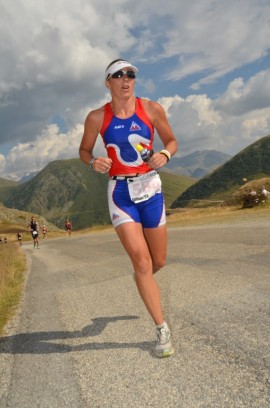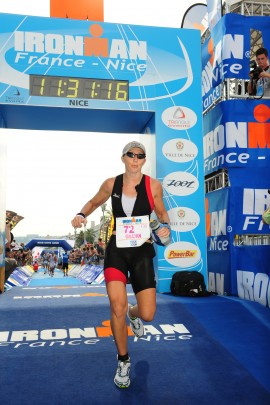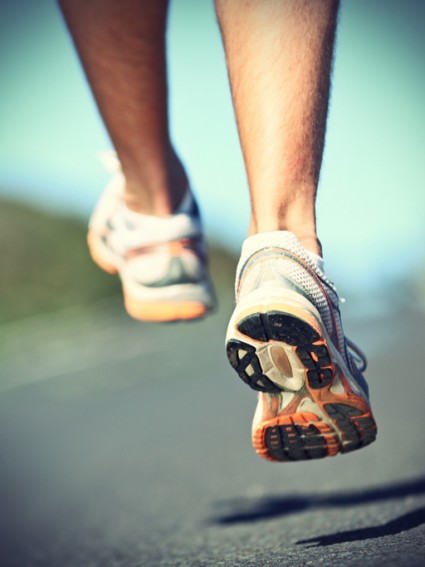


A well-known and common running injury causing pain in the outer knee is ITB syndrome.
The ITB (ilio-tibial band) is a long fascial band that runs between the pelvis and the outer knee. Many refer to it as ITB ‘friction’ syndrome, but it is more of a ‘repetitive compression’ syndrome due to the ITB connecting with the lateral femoral condyle (outer big lump of bone at the side of the knee) when it is pulled tight higher up at hip level due to a poorly controlled pelvis.
When you stand on 2 legs, the pelvis is held up equally on both sides. Think of the pelvis as a tabletop, and the 2 legs on each end of the table equate to one of our legs. Now chop off the 2 left-side legs of the table and what happens? The tabletop certainly won’t remain level – the tabletop drops down on the unsupported side (as can be seen in this photo of me at the end of Nice IronMan).
It’s the same situation when one of our legs leaves the ground (which is what happens over and over with running). The pelvis on the unsupported side should drop down with gravity. Except that in a well-functioning body it doesn’t – why? That is where the hip stabilisers (specifically abductors) come in.
This group of muscle's function is to keep the pelvis level when standing on one leg. And when they aren’t functioning properly, the pelvis will drop on the unsupported side, causing a cascade of events – the ITB on the supporting side suddenly has to cover a longer distance on its way to the knee as its origin on the pelvis has moved away from the insertion at the knee.
The ITB is never "tight" without a reason
 The femur (thigh bone) also tends to twist inwards when the pelvis drops, which takes the ITB insertion further away from the origin. Which means that both the origin and insertion are taken further away from each other which causes the ITB to bowstring and make contact over and over and over against the femoral condyle and BOOM! Pain!
The femur (thigh bone) also tends to twist inwards when the pelvis drops, which takes the ITB insertion further away from the origin. Which means that both the origin and insertion are taken further away from each other which causes the ITB to bowstring and make contact over and over and over against the femoral condyle and BOOM! Pain!
Well firstly I start with a slow motion running assessment to confirm the biomechanical cause.
If a pelvic control issue is at the heart of the problem, work begins not only to strengthen the hip muscles, but to make sure the brain knows when to recruit the right muscles at the right time.
I hear so many patients tell me they have ‘weak glutes’, when their glut strength is actually good. It’s their brain which isn’t communicating properly with the right muscles at the right time.
Like an orchestra that has all the right instruments but a poor conductor! Interestingly, if you instruct a runner with ITB pain to try and run faster, their pain invariably lessens immediately – this is because the increased demand gets the right muscles firing with better timing.
I also ensure maximum joint and muscle flexibility/strength is maintained but my main focus is definitely movement patterning, not only during your run, but looking at how you move during key aspects of your daily functional life.
After all, no-one teaches us how to move, so we all pick up bad habits without knowing it.

Mom of 3 and Specialist Lower Limb Physio Tara Crossley tells us why she runs…
“Hip Hike” is an great pelvic control exercise for runners. Gillian Newey talks us through it.
Wall Climbers is a great running exercise for improving triple flexion and extension. Tara Crossley talks us through it.